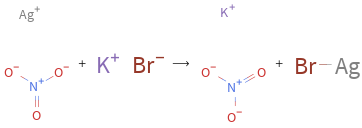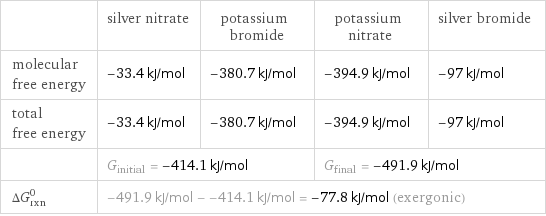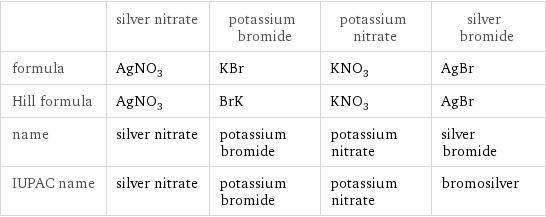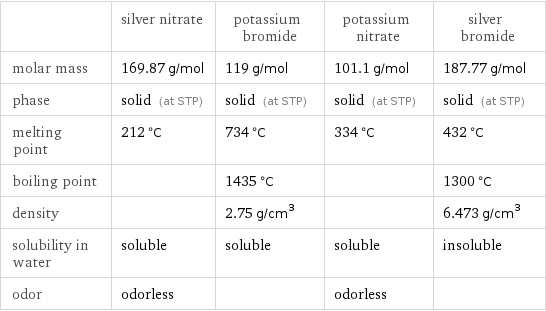Input interpretation

AgNO_3 (silver nitrate) + KBr (potassium bromide) ⟶ KNO_3 (potassium nitrate) + AgBr (silver bromide)
Balanced equation

Balance the chemical equation algebraically: AgNO_3 + KBr ⟶ KNO_3 + AgBr Add stoichiometric coefficients, c_i, to the reactants and products: c_1 AgNO_3 + c_2 KBr ⟶ c_3 KNO_3 + c_4 AgBr Set the number of atoms in the reactants equal to the number of atoms in the products for Ag, N, O, Br and K: Ag: | c_1 = c_4 N: | c_1 = c_3 O: | 3 c_1 = 3 c_3 Br: | c_2 = c_4 K: | c_2 = c_3 Since the coefficients are relative quantities and underdetermined, choose a coefficient to set arbitrarily. To keep the coefficients small, the arbitrary value is ordinarily one. For instance, set c_1 = 1 and solve the system of equations for the remaining coefficients: c_1 = 1 c_2 = 1 c_3 = 1 c_4 = 1 Substitute the coefficients into the chemical reaction to obtain the balanced equation: Answer: | | AgNO_3 + KBr ⟶ KNO_3 + AgBr
Structures

+ ⟶ +
Names

silver nitrate + potassium bromide ⟶ potassium nitrate + silver bromide
Reaction thermodynamics
Enthalpy

| silver nitrate | potassium bromide | potassium nitrate | silver bromide molecular enthalpy | -124.4 kJ/mol | -393.8 kJ/mol | -494.6 kJ/mol | -100 kJ/mol total enthalpy | -124.4 kJ/mol | -393.8 kJ/mol | -494.6 kJ/mol | -100 kJ/mol | H_initial = -518.2 kJ/mol | | H_final = -594.6 kJ/mol | ΔH_rxn^0 | -594.6 kJ/mol - -518.2 kJ/mol = -76.4 kJ/mol (exothermic) | | |
Gibbs free energy

| silver nitrate | potassium bromide | potassium nitrate | silver bromide molecular free energy | -33.4 kJ/mol | -380.7 kJ/mol | -394.9 kJ/mol | -97 kJ/mol total free energy | -33.4 kJ/mol | -380.7 kJ/mol | -394.9 kJ/mol | -97 kJ/mol | G_initial = -414.1 kJ/mol | | G_final = -491.9 kJ/mol | ΔG_rxn^0 | -491.9 kJ/mol - -414.1 kJ/mol = -77.8 kJ/mol (exergonic) | | |
Equilibrium constant
![Construct the equilibrium constant, K, expression for: AgNO_3 + KBr ⟶ KNO_3 + AgBr Plan: • Balance the chemical equation. • Determine the stoichiometric numbers. • Assemble the activity expression for each chemical species. • Use the activity expressions to build the equilibrium constant expression. Write the balanced chemical equation: AgNO_3 + KBr ⟶ KNO_3 + AgBr Assign stoichiometric numbers, ν_i, using the stoichiometric coefficients, c_i, from the balanced chemical equation in the following manner: ν_i = -c_i for reactants and ν_i = c_i for products: chemical species | c_i | ν_i AgNO_3 | 1 | -1 KBr | 1 | -1 KNO_3 | 1 | 1 AgBr | 1 | 1 Assemble the activity expressions accounting for the state of matter and ν_i: chemical species | c_i | ν_i | activity expression AgNO_3 | 1 | -1 | ([AgNO3])^(-1) KBr | 1 | -1 | ([KBr])^(-1) KNO_3 | 1 | 1 | [KNO3] AgBr | 1 | 1 | [AgBr] The equilibrium constant symbol in the concentration basis is: K_c Mulitply the activity expressions to arrive at the K_c expression: Answer: | | K_c = ([AgNO3])^(-1) ([KBr])^(-1) [KNO3] [AgBr] = ([KNO3] [AgBr])/([AgNO3] [KBr])](../image_source/fcf8a7ab1eaa04f2ba026b2e4939dd90.png)
Construct the equilibrium constant, K, expression for: AgNO_3 + KBr ⟶ KNO_3 + AgBr Plan: • Balance the chemical equation. • Determine the stoichiometric numbers. • Assemble the activity expression for each chemical species. • Use the activity expressions to build the equilibrium constant expression. Write the balanced chemical equation: AgNO_3 + KBr ⟶ KNO_3 + AgBr Assign stoichiometric numbers, ν_i, using the stoichiometric coefficients, c_i, from the balanced chemical equation in the following manner: ν_i = -c_i for reactants and ν_i = c_i for products: chemical species | c_i | ν_i AgNO_3 | 1 | -1 KBr | 1 | -1 KNO_3 | 1 | 1 AgBr | 1 | 1 Assemble the activity expressions accounting for the state of matter and ν_i: chemical species | c_i | ν_i | activity expression AgNO_3 | 1 | -1 | ([AgNO3])^(-1) KBr | 1 | -1 | ([KBr])^(-1) KNO_3 | 1 | 1 | [KNO3] AgBr | 1 | 1 | [AgBr] The equilibrium constant symbol in the concentration basis is: K_c Mulitply the activity expressions to arrive at the K_c expression: Answer: | | K_c = ([AgNO3])^(-1) ([KBr])^(-1) [KNO3] [AgBr] = ([KNO3] [AgBr])/([AgNO3] [KBr])
Rate of reaction
![Construct the rate of reaction expression for: AgNO_3 + KBr ⟶ KNO_3 + AgBr Plan: • Balance the chemical equation. • Determine the stoichiometric numbers. • Assemble the rate term for each chemical species. • Write the rate of reaction expression. Write the balanced chemical equation: AgNO_3 + KBr ⟶ KNO_3 + AgBr Assign stoichiometric numbers, ν_i, using the stoichiometric coefficients, c_i, from the balanced chemical equation in the following manner: ν_i = -c_i for reactants and ν_i = c_i for products: chemical species | c_i | ν_i AgNO_3 | 1 | -1 KBr | 1 | -1 KNO_3 | 1 | 1 AgBr | 1 | 1 The rate term for each chemical species, B_i, is 1/ν_i(Δ[B_i])/(Δt) where [B_i] is the amount concentration and t is time: chemical species | c_i | ν_i | rate term AgNO_3 | 1 | -1 | -(Δ[AgNO3])/(Δt) KBr | 1 | -1 | -(Δ[KBr])/(Δt) KNO_3 | 1 | 1 | (Δ[KNO3])/(Δt) AgBr | 1 | 1 | (Δ[AgBr])/(Δt) (for infinitesimal rate of change, replace Δ with d) Set the rate terms equal to each other to arrive at the rate expression: Answer: | | rate = -(Δ[AgNO3])/(Δt) = -(Δ[KBr])/(Δt) = (Δ[KNO3])/(Δt) = (Δ[AgBr])/(Δt) (assuming constant volume and no accumulation of intermediates or side products)](../image_source/e9a4bf5692daf4bb3abca2e09e4617b2.png)
Construct the rate of reaction expression for: AgNO_3 + KBr ⟶ KNO_3 + AgBr Plan: • Balance the chemical equation. • Determine the stoichiometric numbers. • Assemble the rate term for each chemical species. • Write the rate of reaction expression. Write the balanced chemical equation: AgNO_3 + KBr ⟶ KNO_3 + AgBr Assign stoichiometric numbers, ν_i, using the stoichiometric coefficients, c_i, from the balanced chemical equation in the following manner: ν_i = -c_i for reactants and ν_i = c_i for products: chemical species | c_i | ν_i AgNO_3 | 1 | -1 KBr | 1 | -1 KNO_3 | 1 | 1 AgBr | 1 | 1 The rate term for each chemical species, B_i, is 1/ν_i(Δ[B_i])/(Δt) where [B_i] is the amount concentration and t is time: chemical species | c_i | ν_i | rate term AgNO_3 | 1 | -1 | -(Δ[AgNO3])/(Δt) KBr | 1 | -1 | -(Δ[KBr])/(Δt) KNO_3 | 1 | 1 | (Δ[KNO3])/(Δt) AgBr | 1 | 1 | (Δ[AgBr])/(Δt) (for infinitesimal rate of change, replace Δ with d) Set the rate terms equal to each other to arrive at the rate expression: Answer: | | rate = -(Δ[AgNO3])/(Δt) = -(Δ[KBr])/(Δt) = (Δ[KNO3])/(Δt) = (Δ[AgBr])/(Δt) (assuming constant volume and no accumulation of intermediates or side products)
Chemical names and formulas

| silver nitrate | potassium bromide | potassium nitrate | silver bromide formula | AgNO_3 | KBr | KNO_3 | AgBr Hill formula | AgNO_3 | BrK | KNO_3 | AgBr name | silver nitrate | potassium bromide | potassium nitrate | silver bromide IUPAC name | silver nitrate | potassium bromide | potassium nitrate | bromosilver
Substance properties

| silver nitrate | potassium bromide | potassium nitrate | silver bromide molar mass | 169.87 g/mol | 119 g/mol | 101.1 g/mol | 187.77 g/mol phase | solid (at STP) | solid (at STP) | solid (at STP) | solid (at STP) melting point | 212 °C | 734 °C | 334 °C | 432 °C boiling point | | 1435 °C | | 1300 °C density | | 2.75 g/cm^3 | | 6.473 g/cm^3 solubility in water | soluble | soluble | soluble | insoluble odor | odorless | | odorless |
Units
